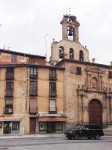The gunshot explodes and the wooden gates swing open, releasing more than half a dozen bulls into the narrow streets of Pamplona, Spain.
Thousands of people outside the gates, wearing red kerchiefs around their necks, burst into a sprint, trying to outrun the animals. The resounding bells growing louder warn the runners that the bulls are close behind.
The annual San Fermin encierro, or the running of the bulls, starts with a bang. The ceremony is a tradition that is centuries-old, and my roommate and I talked about going to see it before we even arrived in Spain. Several members of our group naively wanted to go run with the bulls too, and we thought we would make a weekend out of it.
But our hopes were quickly dashed.
Every person we met discouraged us from attending the ceremony because it can be dangerous. It’s crowded, out of control and pickpockets are everywhere in Pamplona for the festival. Downhearted, we settled for watching it at home.
The festival was on most Salamantinos’ minds this week.
Each day at exactly 8 a.m. the bulls are released to chase people through the streets. The festival lasts for a week: July 6-14. The encierro, though, is just one tradition of many in the festival. Bullfights and other ceremonies take place throughout the week.
For many runners, the bulls are too quick. The slower runners fall to the ground when they sense the animals closing in on them. The bulls eventually part the crowd of runners like Moses parting the Red Sea.
Most of the runners make it to the side to safety, or get lucky. But every year since the festival started in 1591, runners are seriously injured, with several deaths reported in the past 100 years of the festival. One of my professors remarked it made her so nervous, she didn’t even know why she watched it.
Still, the tradition is vital in every city in Spain – not just in Pamplona, where it takes place.
Milagros, my host mother, said that despite the gore, she still respects the tradition. The first few mornings of the festival, she woke up early to watch the encierro on television before going back to sleep. My Spanish professors at the Universidad de Salamanca told us they followed it each day, too.
During dinner one evening before the festival, Milagros casually chatted about how the bullfighters take an arrow to behead bulls after their victories, spraying the crowd with blood. It was all I could do to keep down the otherwise delicious piece of beef she had cooked. I couldn’t wrap my head around why so many watched the ceremony in the name of tradition.
According to Milagros, the course of the race never changes from year to year; only new brave souls take it on.
After several failed attempts using the overhead projector to watch this year’s festival in class, one of my professors showed us an encierro from 2013. When I found the current festival’s event online later, my host mother’s words rang true; it was almost identical. More than the similarity, though, I realized how exciting and unifying it was to watch it, knowing thousands of others were too.
I found my respect for the tradition. Next time, I hope to see it for myself.
